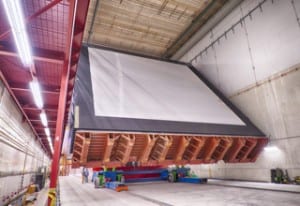Elusive particle that is one of the building blocks of matter holds the key to space, time, matter, energy and origins of the universe
When scientists pour 3.0 million gallons of mineral oil into what are essentially 350,000 giant plastic tubes, the possibility of a leak can’t be overlooked, says SMU physicist Thomas E. Coan.
The oil and tubes are part of the integral structure of the world’s newest experiment to understand neutrinos — invisible fundamental particles that are so abundant they constantly bombard us and pass through us at a rate of more than 100,000 billion particles a second.
Neutrinos rarely interact with matter and so mostly pass through objects completely unnoticed. The purpose of NOvA, as the new experiment is called, is to better understand neutrinos. That knowledge may lead to a clearer picture of the origins of matter and the inner workings of the universe, Coan said.
”Neutrinos are thought to play a key but still somewhat murky role in explaining how the universe evolved to contain just the matter we see today and somehow disposing of the antimatter present at the Big Bang,” he said.

Coan is an associate professor in the SMU Department of Physics and a member of the NOvA experiment. “Solving this riddle is likely to require many experiments to get the story correct,” he said. “NOvA is a next step along what is likely to be a twisty path.”
At the heart of NOvA are its two particle detectors — gigantic machines of plastic and electronic arrays, one at the U.S. Department of Energy’s Fermi National Accelerator Laboratory near Chicago and the other in Ash River, Minn. near the Canadian border.
Designed and engineered by about a hundred U.S. and international scientists, NOvA is managed by Fermilab. NOvA’s detectors and its particle accelerator officially start up the end of October.
“There are essentially zero leaks,” Coan said. “This was a bit of a surprise. It guarantees that critical electronics won’t be damaged by leaking oil and that the detector will be highly efficient for detecting the neutrinos we aim at it.”
One of the largest and most powerful neutrino experiments in the world, NOvA is funded by the National Science Foundation and the U.S. Department of Energy.

It has the world’s most powerful beam of neutrinos, is the most powerful accelerator neutrino experiment ever built in the United States, and is the longest distance neutrino experiment in the world.
Coan, a co-convener of NOvA’s calibration and alignment group, guides a crew of international scientists who handle responsibility for understanding the response of NOvA’s detector when it is struck by neutrinos.
“The detector has been behaving extremely well,” Coan said, noting NOvA scientists were delighted by the machine’s successful performance during testing after five years of construction.
Neutrino beam will travel near speed of light
Central to the detector are its rectangular plastic tubes staggered in horizontal and vertical layers. As neutrinos strike the oil-filled plastic tubes, the interaction makes the oil — liquid scintillator — faintly glow and creates various particles.
Special green fiberoptic cables in the plastic tubes transmit the faint glow from the liquid scintillator to photosensors at one end of each tube, where the light is converted to bursts of electricity which in turn are sent to nearby computers.

“We don’t actually see the neutrinos,” Coan said. “We see the particles that are the after-party — the final state particles produced by the neutrinos after they strike the detector.”
SMU’s supercomputer ManeFrame will have a high-profile role with NOvA. SMU will contribute four million processing hours each year to the experiment, Coan said.
The process begins when NOvA’s underground accelerator near Chicago shoots a beam of neutrinos at nearly the speed of light to the particle detectors. Plans call for the accelerator to run for six years or more, stopping only occasionally for maintenance breaks.
“This is a long process,” Coan said. “That is uncommon in our modern culture where we tend to expect quick results. But it will take time for us to capture enough data to do all the science we want to do. It will take years. In a couple weeks Fermilab will start bringing the beam back — which is a more complicated process than just pushing a few buttons and starting it up.”
Scientists hope to discover the properties of neutrinos
NOvA’s purpose is to capture a significant volume of data to allow scientists to draw conclusions about the properties of neutrinos.
Those properties may hold answers to the nature of matter, energy, space and time, and lead to understanding the origins of the universe.
Specifically, Coan said, NOvA physicists want to know how different types of neutrinos morph from one kind to another, the probability for that to occur, the relative weight of neutrinos, and the difference in behavior between neutrinos and anti-neutrinos.
NOvA’s particle detectors were both constructed within the neutrino beam sent from Fermilab in Batavia, Ill. to northern Minnesota. The 300-ton near detector observes the neutrinos as they embark on their journey through the earth, with no tunnel needed. The 14,000-ton far detector spots those neutrinos after their 500-mile trip, and allows scientists to analyze how they change over that long distance.
Construction on NOvA’s two massive neutrino detectors began in 2009. The Department of Energy in September said construction of the experiment was completed on schedule and under budget.
Scientists predict detectors will catch only a few neutrinos a day
For the next six years, Fermilab will send tens-of thousands of billions of neutrinos every second in a beam aimed at both detectors, and scientists expect to catch only a few each day in the far detector.
From this data, scientists hope to learn more about how and why neutrinos change between one type and another. The three types, called flavors, are the muon, electron and tau neutrino. Over longer distances, neutrinos can flip between these flavors.
NOvA is specifically designed to study muon neutrinos changing into electron neutrinos. Unraveling this mystery may help scientists understand why the universe is composed of matter, and why that matter was not annihilated by antimatter after the Big Bang.
Scientists also will probe the still-unknown masses of the three types of neutrinos in an attempt to determine which is the heaviest.
“Neutrino research is an important part of the worldwide particle physics program,” said Fermilab Director Nigel Lockyer.
First results expected in 2015
The far detector in Minnesota is believed to be the largest free-standing plastic structure in the world, at 200 feet long, 50 feet high and 50 feet wide. Both detectors are constructed from PVC, and filled with the scintillating liquid that gives off light. The data acquisition system creates 3-D pictures of the interactions for scientists to analyze.
The NOvA far detector in Ash River saw its first long-distance neutrinos in November 2013.
“Building the NOvA detectors was a wide-ranging effort that involved hundreds of people in several countries,” said Gary Feldman, co-spokesperson of the NOvA experiment.
The NOvA collaboration comprises 208 scientists from 38 institutions in the United States, Brazil, the Czech Republic, Greece, India, Russia and the United Kingdom.
NOvA stands for NuMI Off-Axis Electron Neutrino Appearance. NuMI is itself an acronym, standing for Neutrinos from the Main Injector, Fermilab’s flagship accelerator. — Margaret Allen, SMU; Fermilab
Follow SMUResearch.com on twitter at @smuresearch.
SMU is a nationally ranked private university in Dallas founded 100 years ago. Today, SMU enrolls nearly 11,000 students who benefit from the academic opportunities and international reach of seven degree-granting schools. For more information see www.smu.edu.
SMU has an uplink facility located on campus for live TV, radio, or online interviews. To speak with an SMU expert or book an SMU guest in the studio, call SMU News & Communications at 214-768-7650.





 Department of Defense awards $2.6 million to SMU STEM program for minority students
Department of Defense awards $2.6 million to SMU STEM program for minority students